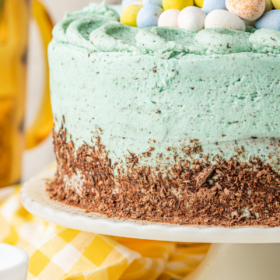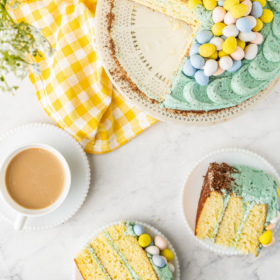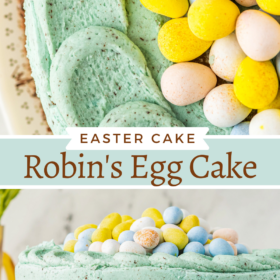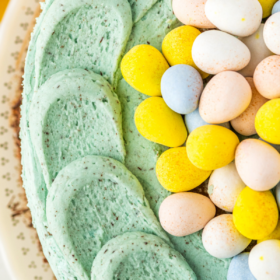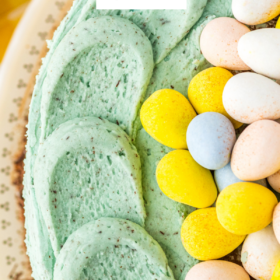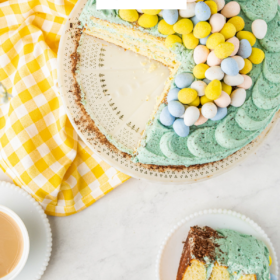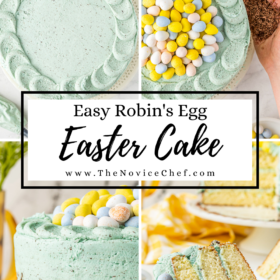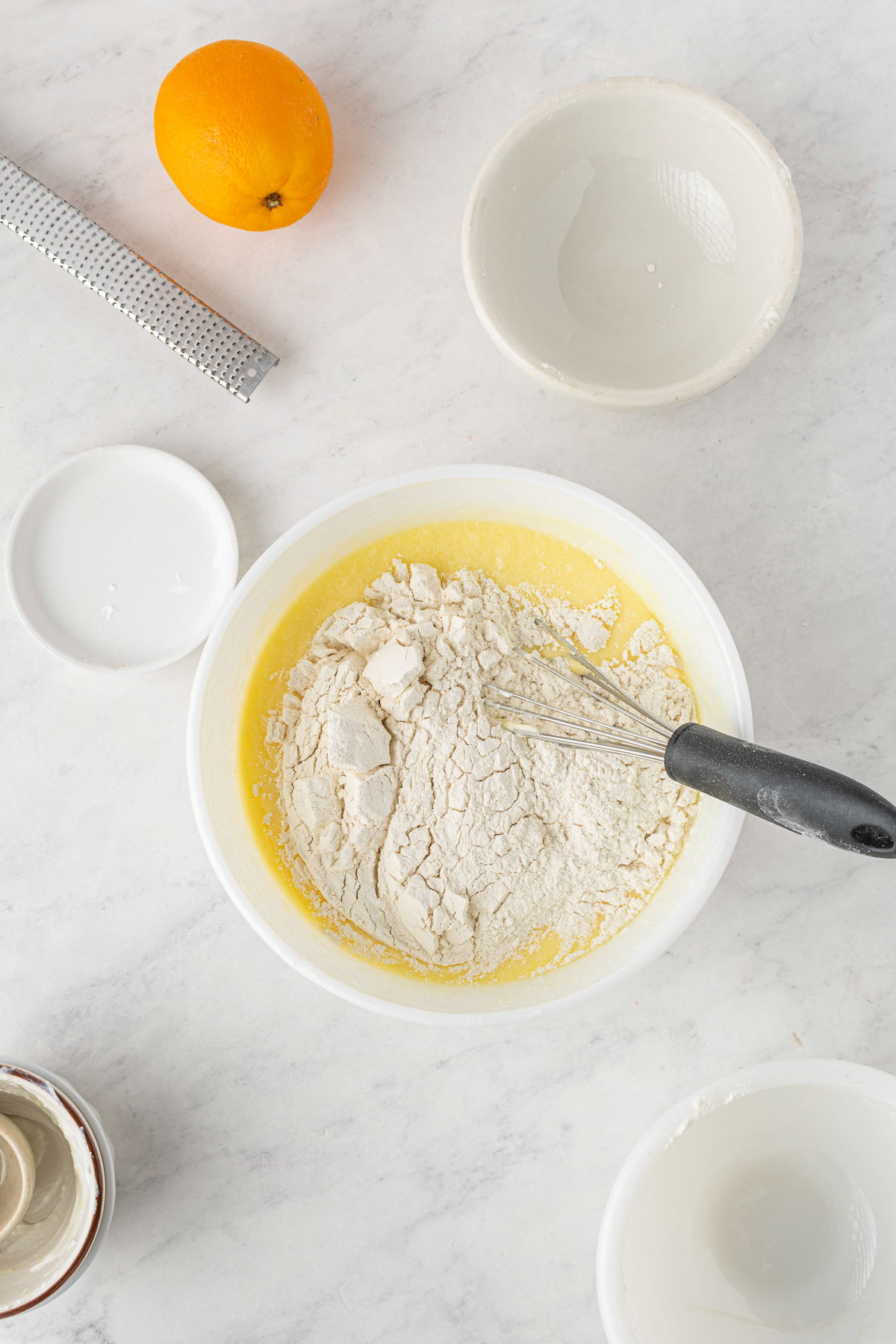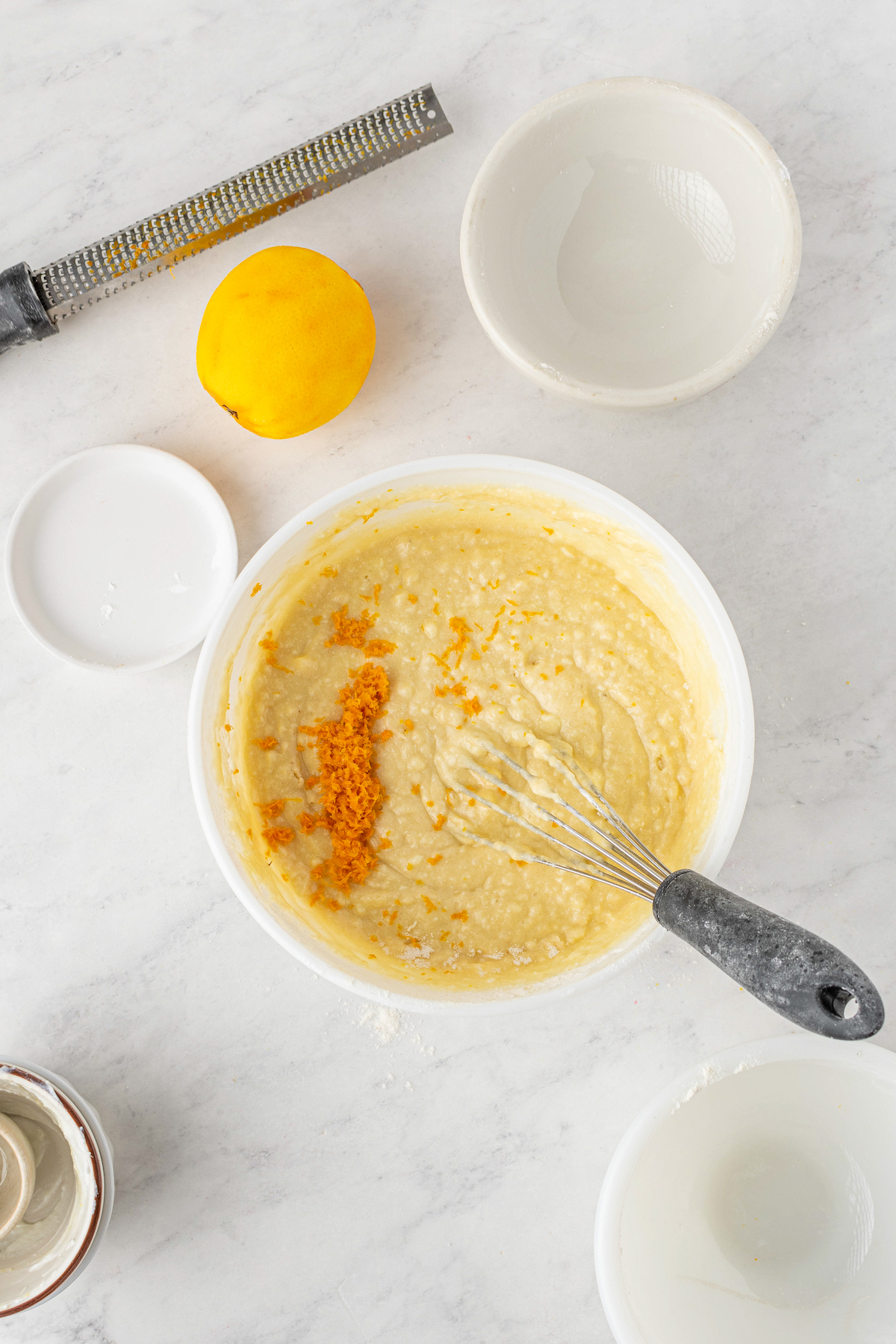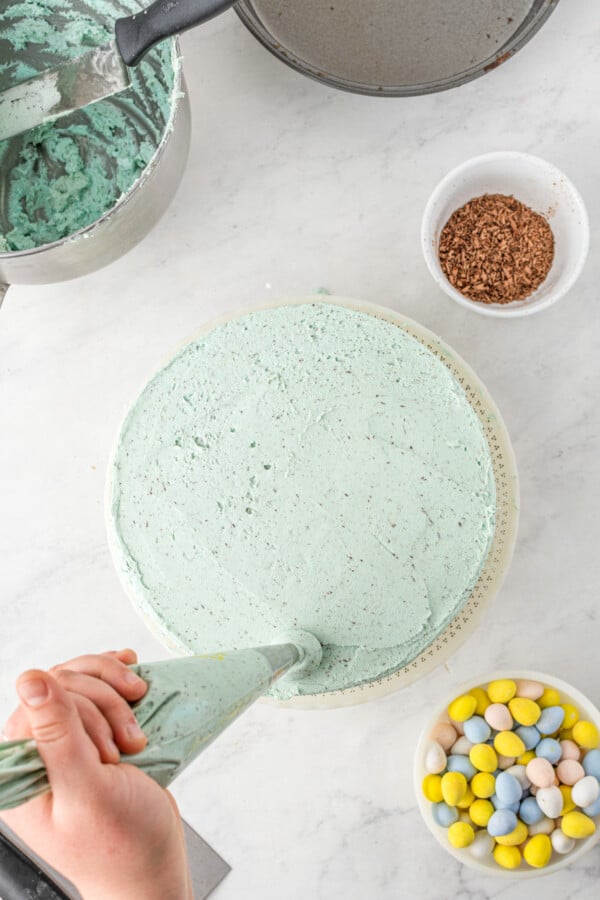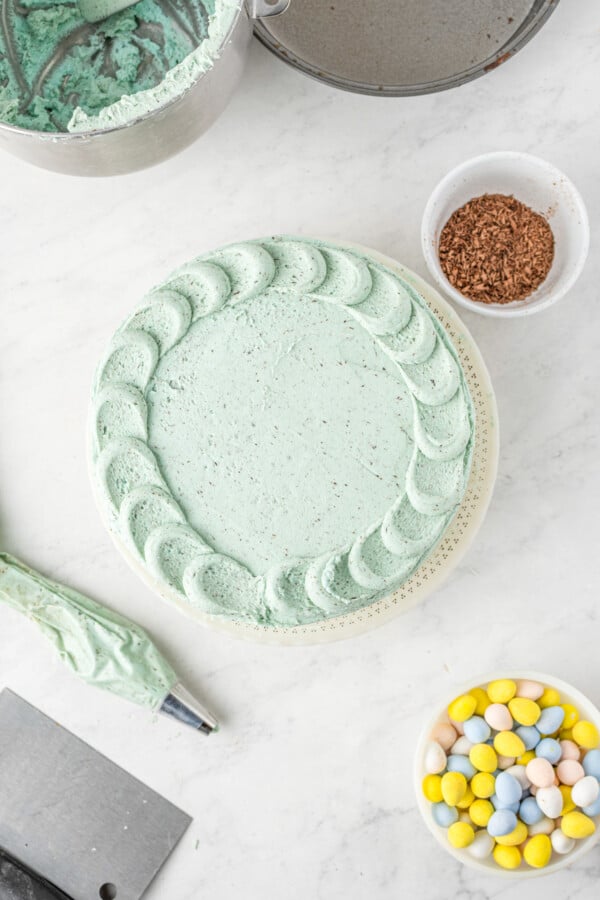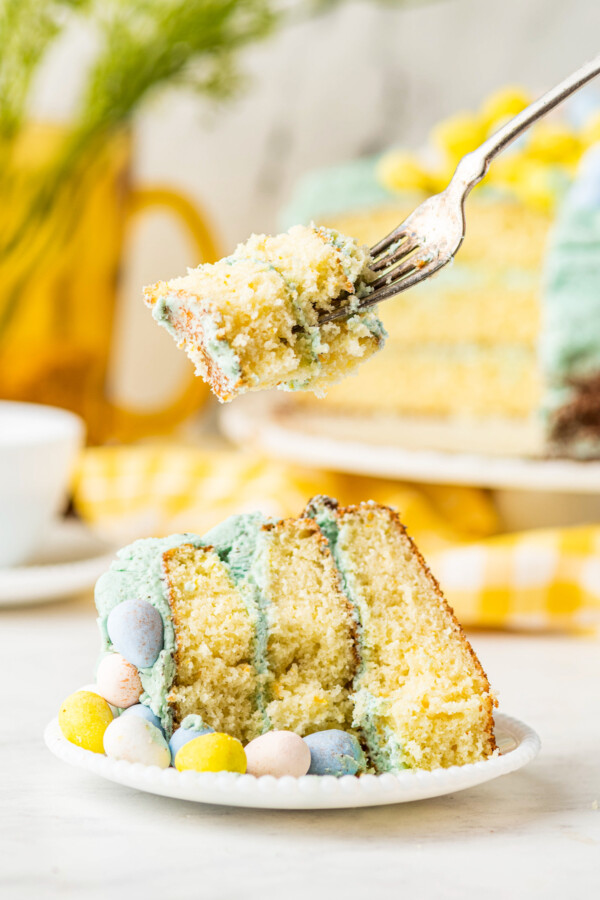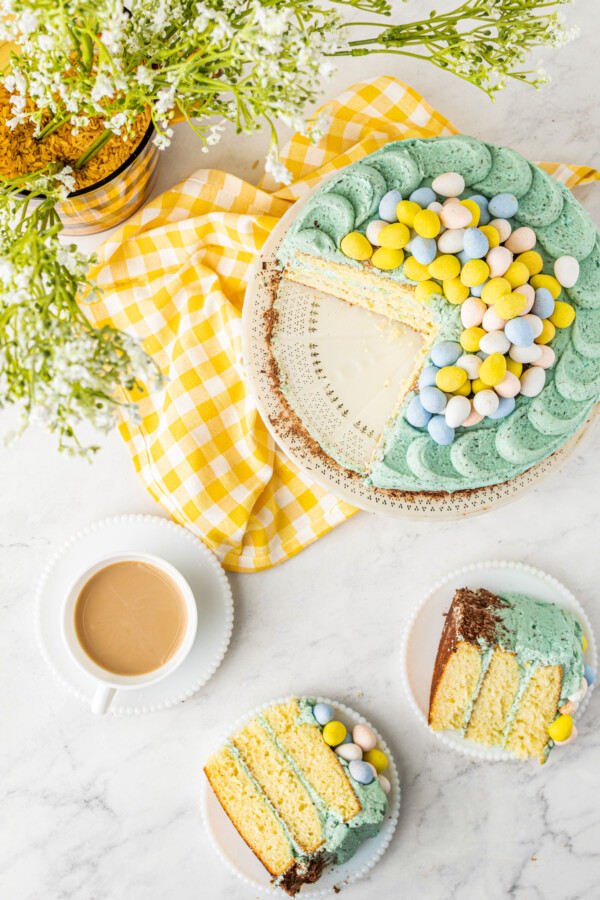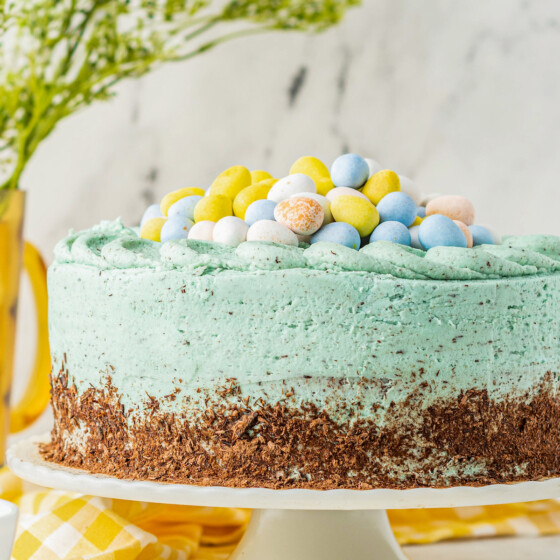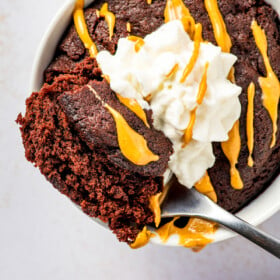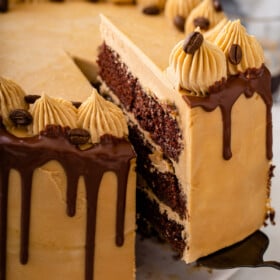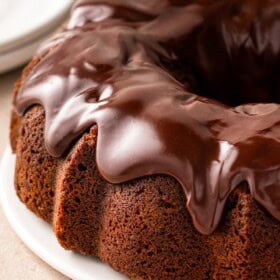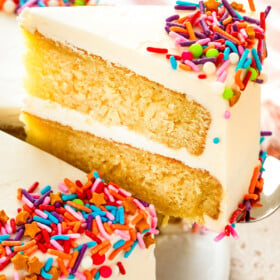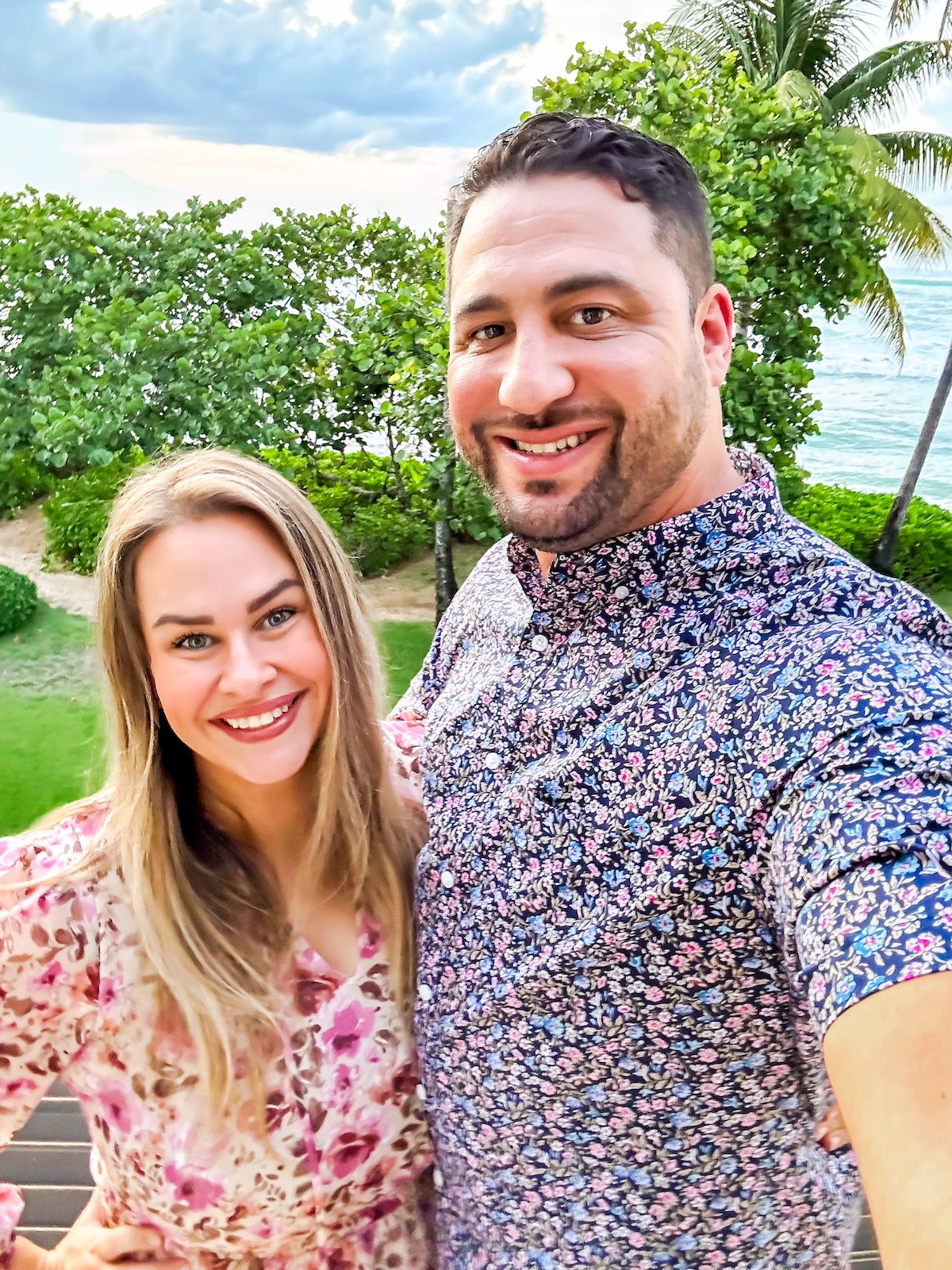This easy Easter Cake is so soft and scrumptious with layers of fluffy vanilla-orange cake, blue Robin’s Egg buttercream frosting and candy mini chocolate eggs on top! It’s the perfect impressive, but still easy, Easter dessert!
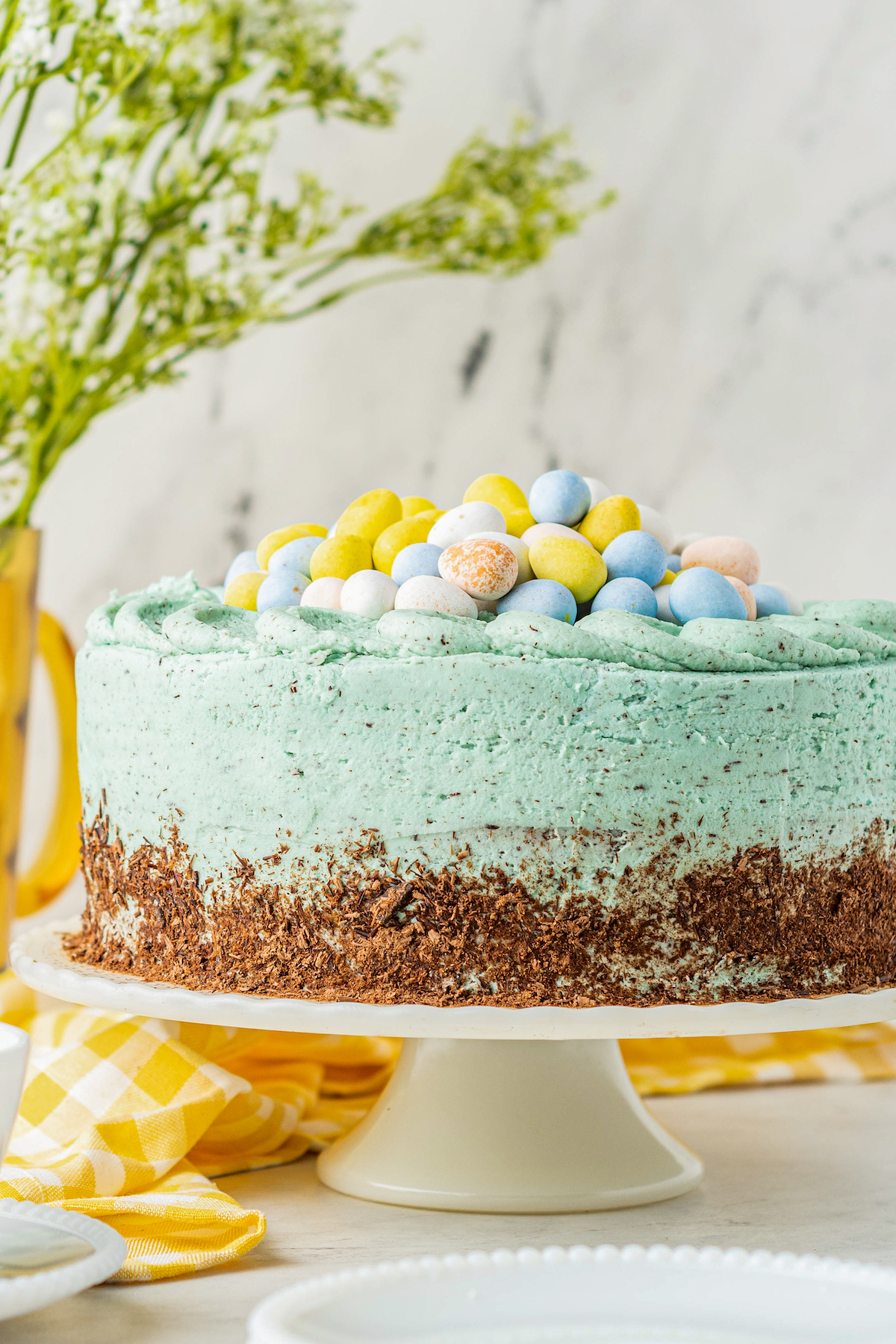
Want to save this recipe?
Moist & Fluffy Easter Cake
There are so many reasons to love Easter and, more specifically, the brunch that comes with it. All of the best breakfast casseroles, fruit salads, and family-favorite recipes are sure to make an appearance!
But the newest reason to count down the days until Easter morning is this Easter Cake. Words cannot describe how good this decadent dessert tastes. The light orange cake and the delicious chocolate go hand in hand to create a perfect Easter dessert. I especially love the Robin’s Egg speckled buttercream frosting. Everyone is going to want a slice!
So… if you want to dig into this impressive Easter Cake while the kids are still busy on their Easter egg hunt… I’m right there with you! Who would even really notice a small slice out of the back?
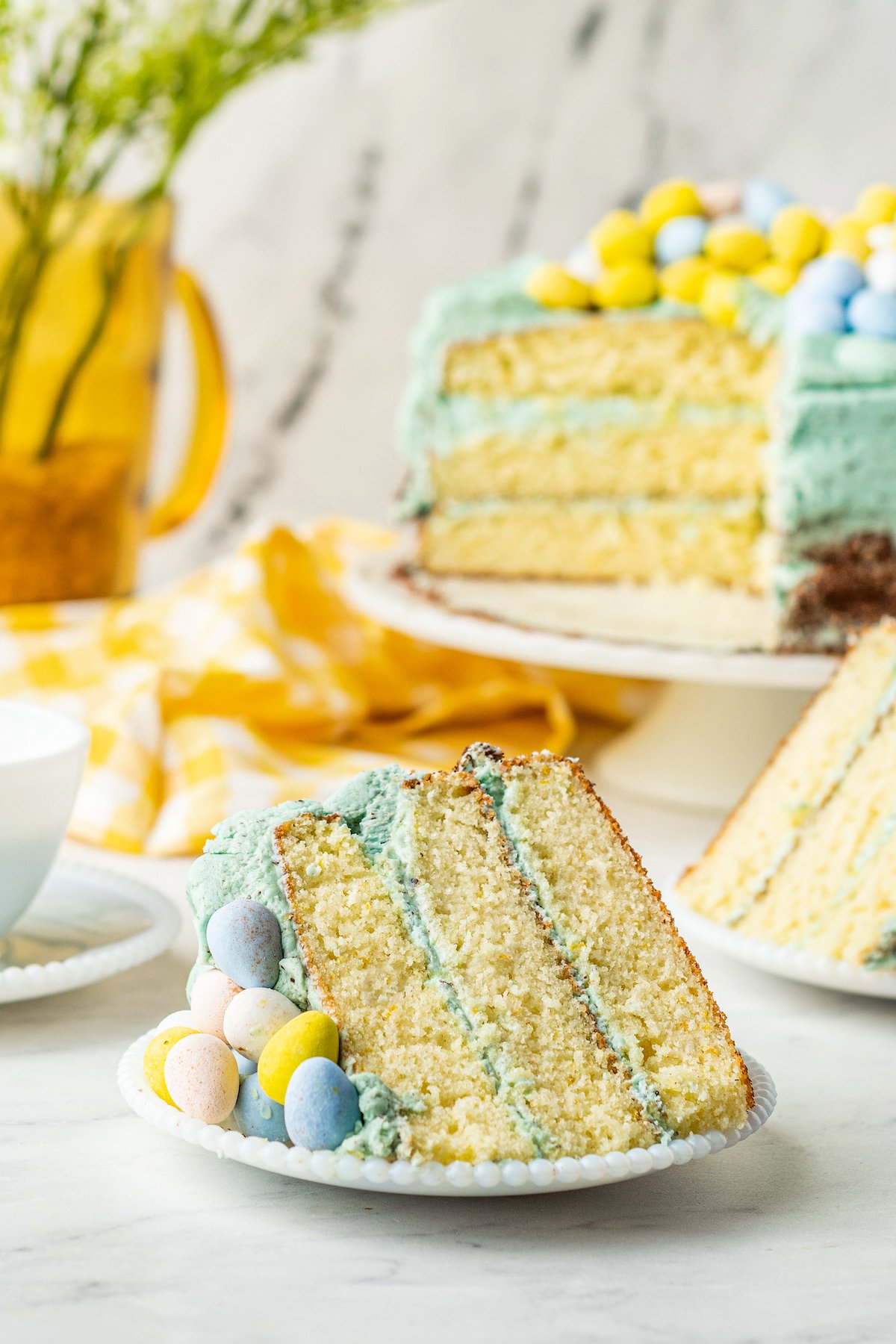
What You’ll Need
Let’s talk cake ingredients. You’ll obviously need more than what is listed here (see recipe card below for the full list) but these are the ingredients that are going to make your cake taste divine!
- Greek Yogurt or Sour Cream – While buttermilk adds obvious moisture to the cake, greek yogurt (or sour cream) adds a silky, rich moisture that takes this cake to the next level.
- Orange Extract – This gives the cake its wonderful flavor, without changing the consistency. If you added orange juice, you would need to adjust the recipe quite a bit to compensate for the added liquid. Orange extract makes it simple.
- Orange Zest – Orange zest helps bring out the orange flavor as well as depth in this delightful cake.
- Shredded Chocolate – For this, I used a vegetable peeler on a bar of Ghirardelli dark chocolate. I first tried a zester/microplane but the pieces were far too small. The use of the shredded chocolate is to complete the buttercream’s robin’s egg effect.
- Cadbury Mini Chocolate Eggs – These mini chocolate eggs have such beautifully colored pastel candy shells that add to the picture-perfect quality of this cake, not to mention the delicious chocolate center itself.
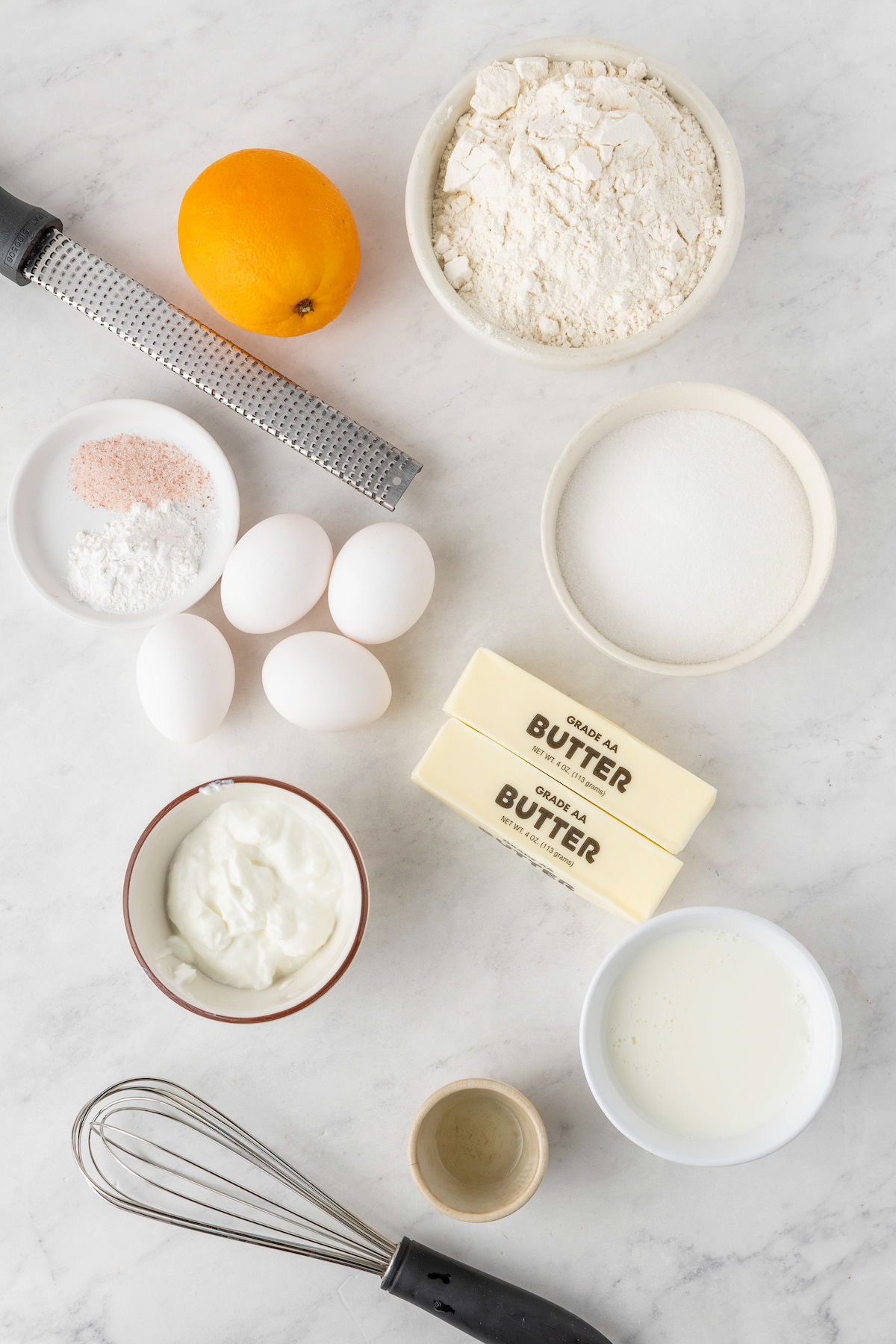
How to Make an Easter Cake
The only thing better than a chocolate-candy-covered cake is a chocolate-candy-covered layer cake. And it’s not even that much more difficult to bake and build!
Make the Easter Cake layers
Grease the Cake Pans: Preheat the oven to 350°F. Spray three 8-inch cake pans with baking spray and set aside. (You can also use two 9-inch cake pans instead.)
Mix Eggs & Sugar: In a large mixing bowl, whisk together the sugar and eggs until smooth. Add in the butter and whisk for a minute or two until the butter is well integrated.
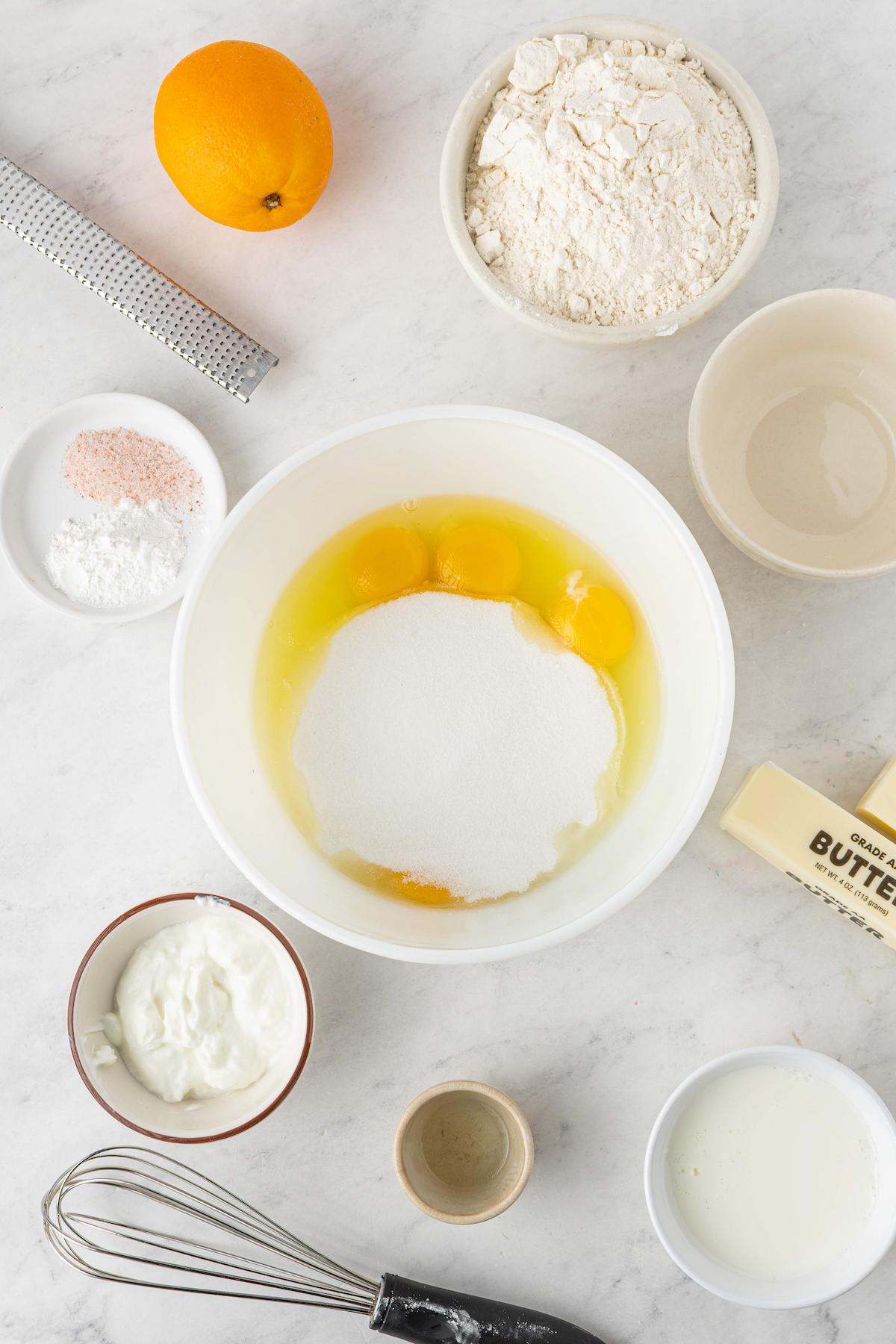
Combine with Buttermilk: Add in the buttermilk, greek yogurt and orange extract. Whisk until smooth. Add in the orange zest and whisk until incorporated.
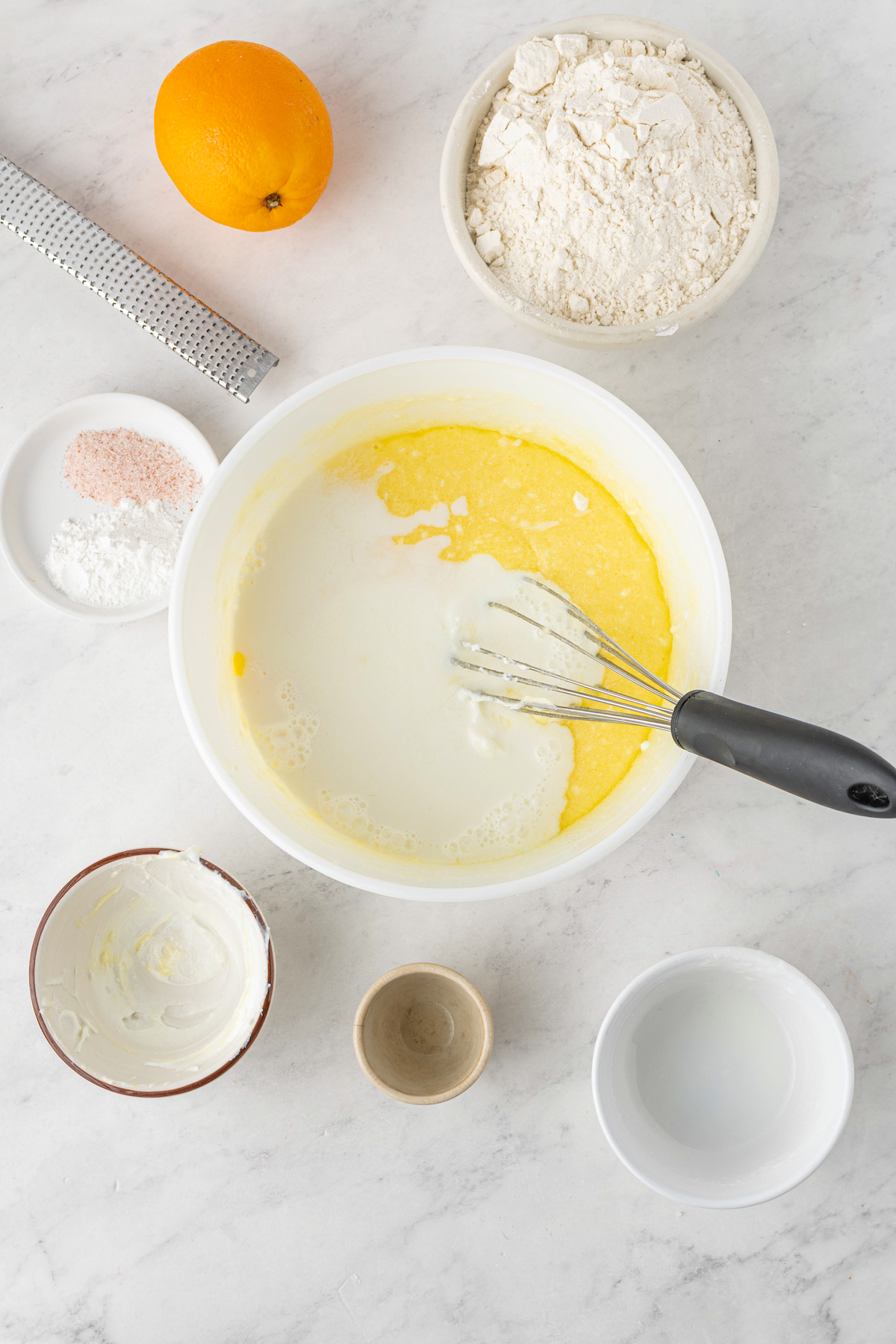
Mix Dry Ingredients Together: In a medium mixing bowl, whisk together the flour, baking powder and salt. Add the flour mixture into the wet mixture and fold together until there are no flour clumps.
Bake the Cakes: Evenly divide into greased cake pans and place into the preheated oven to bake. For 3 cake pans, bake for 12 to 14 minutes or until a toothpick inserted comes out clean or with moist crumbs and the edges are browned and pulling away from the sides of the pan. (For 2 cake pans, expect the baking time to be about 16 to 18 minutes.)
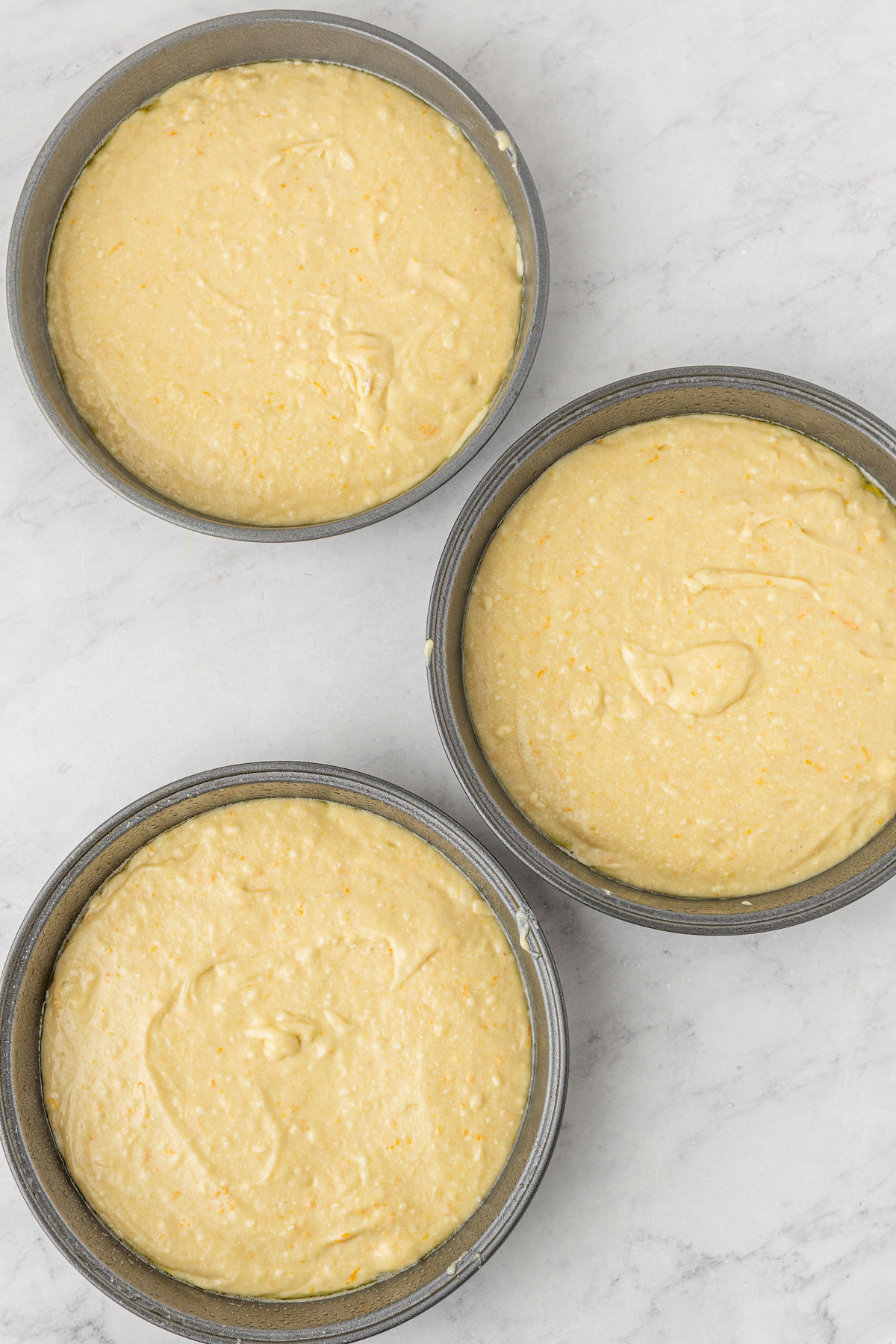
Let the Cakes Cool: Once baked, remove from the oven and place on a cooling rack to cool. While the cakes are cooling, make the buttercream. Once the cakes are cooled and the buttercream is made, remove the cakes from the pans.
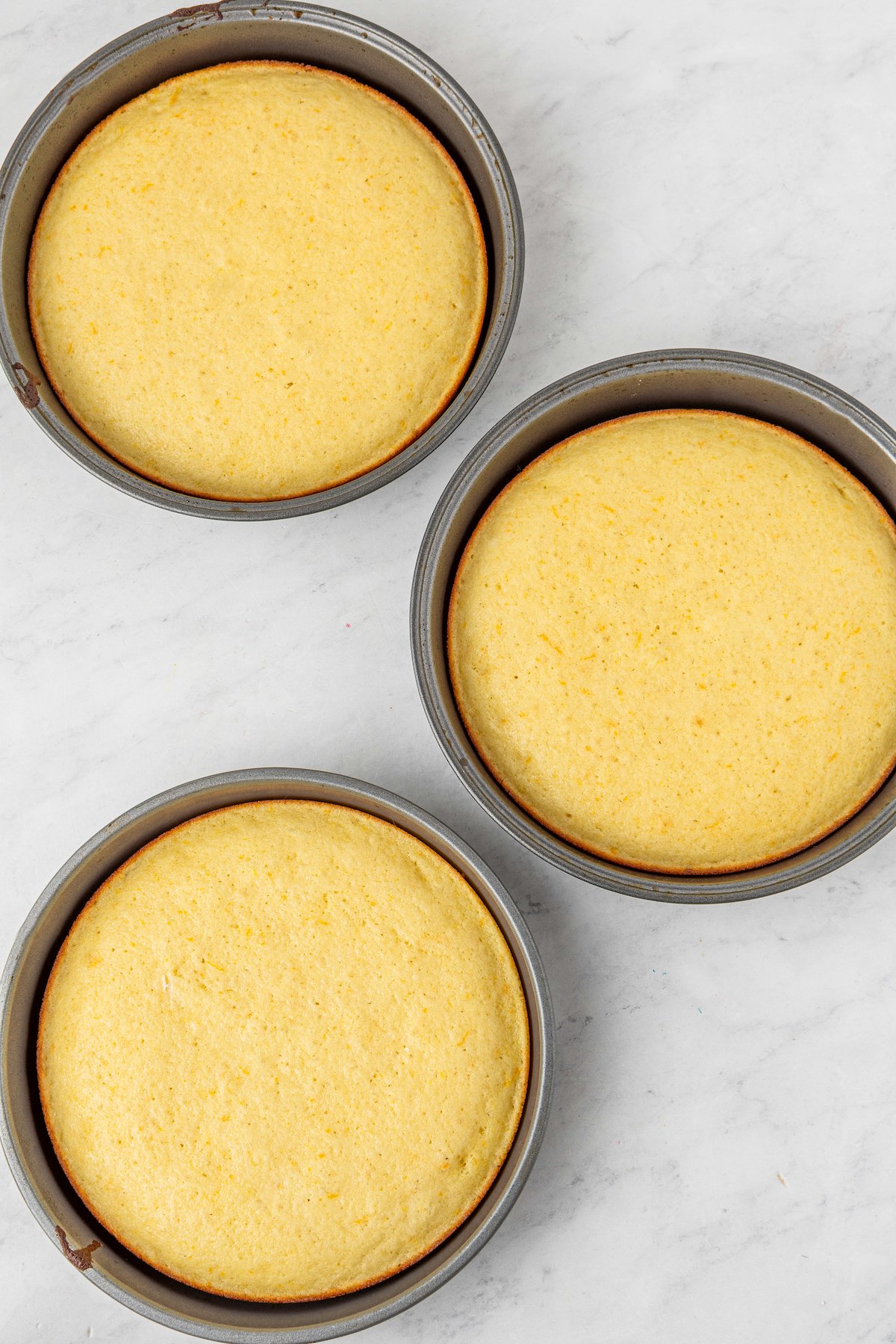
Make the blue buttercream frosting
Whisk the Frosting Together: In the bowl of a stand mixer, combine butter, powdered sugar, milk, vanilla and salt. Using a paddle or whisk attachment, begin beating on low so that the powdered sugar does not explode everywhere.
Beat the Frosting: After a minute or two, once the frosting has started to come together, increase the speed to medium high. Let whip for about 4 minutes or until the buttercream is a light and fluffy texture.
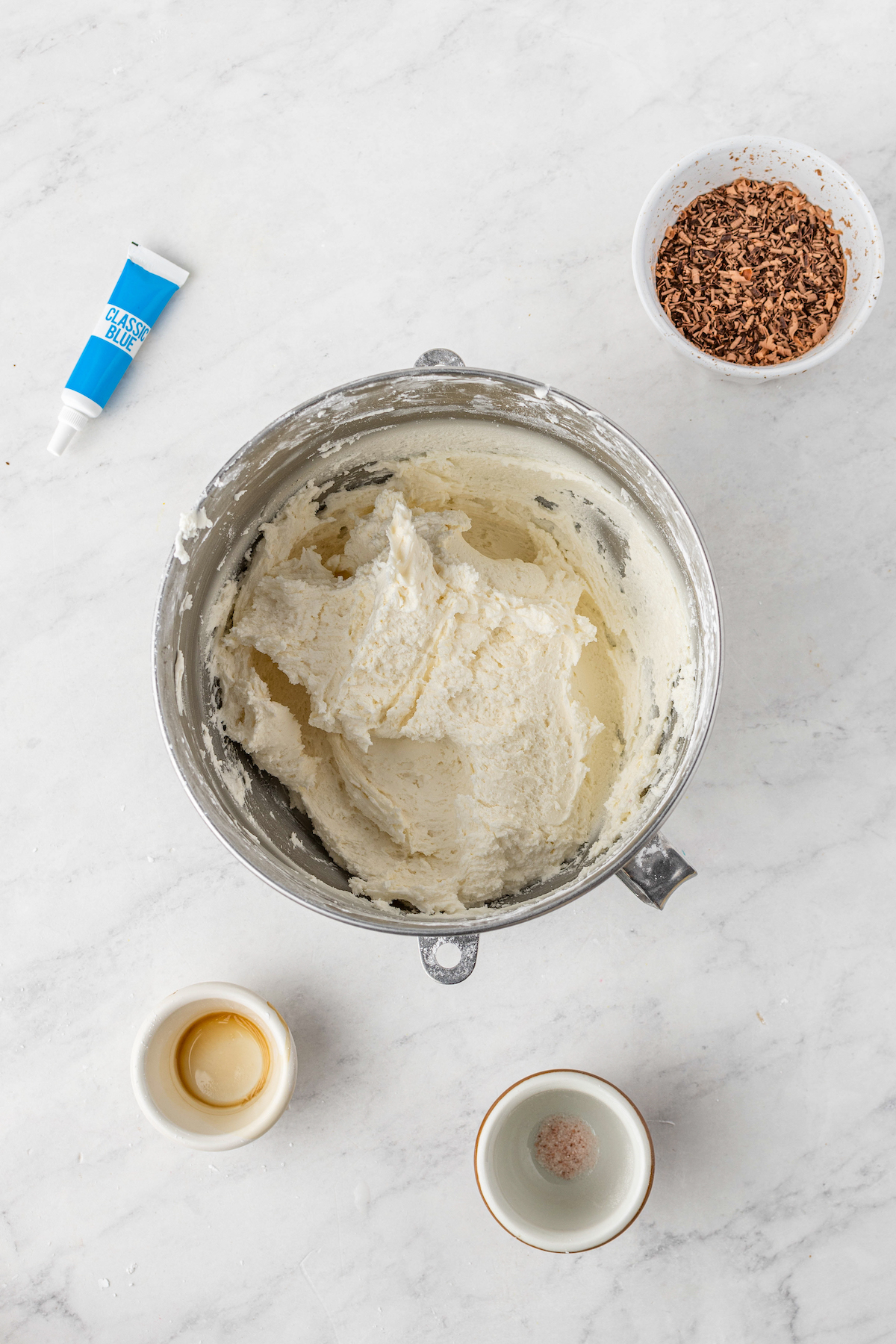
Make the Frosting Blue: Add in blue food coloring, a little at a time until you have reached the desired color.
Make it Speckled: Add in ¾ c of the shredded chocolate. Whip for an additional 30 seconds or until the chocolate is well incorporated. This gives the frosting that speckled appearance like a robin’s egg.
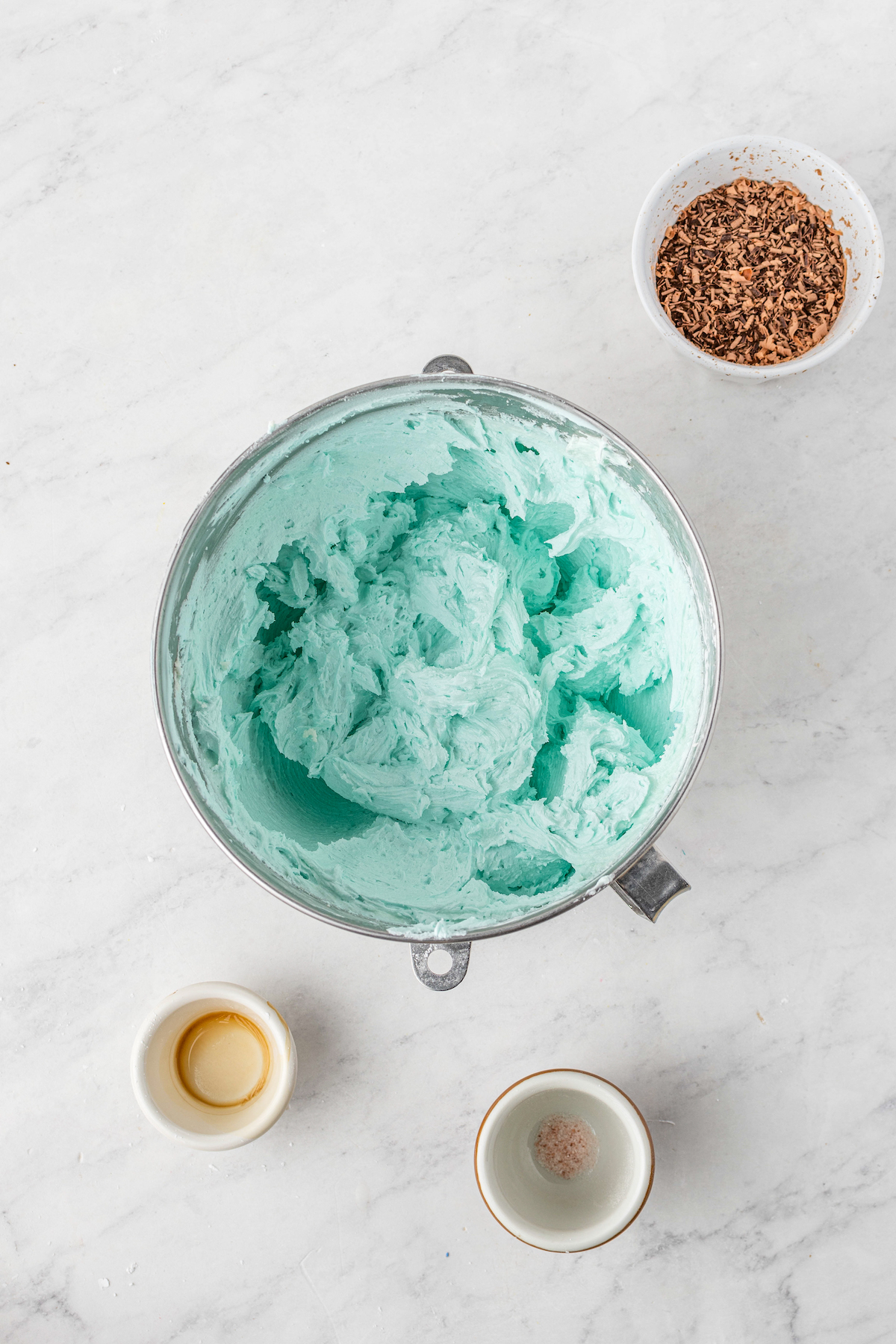
Assemble and Decorate
Add Frosting to the 1st Layer: Place one layer onto a cake stand or a plate. Spoon about ½ – ¾ cup of frosting onto the bottom layer. Using an offset spatula or a bench knife, spread the frosting around in an even layer.
To ensure there are no gaps or space around the edges where the cakes will be stacked, spread the frosting all the way to the edge without scraping the excess away – we will clean it up later.
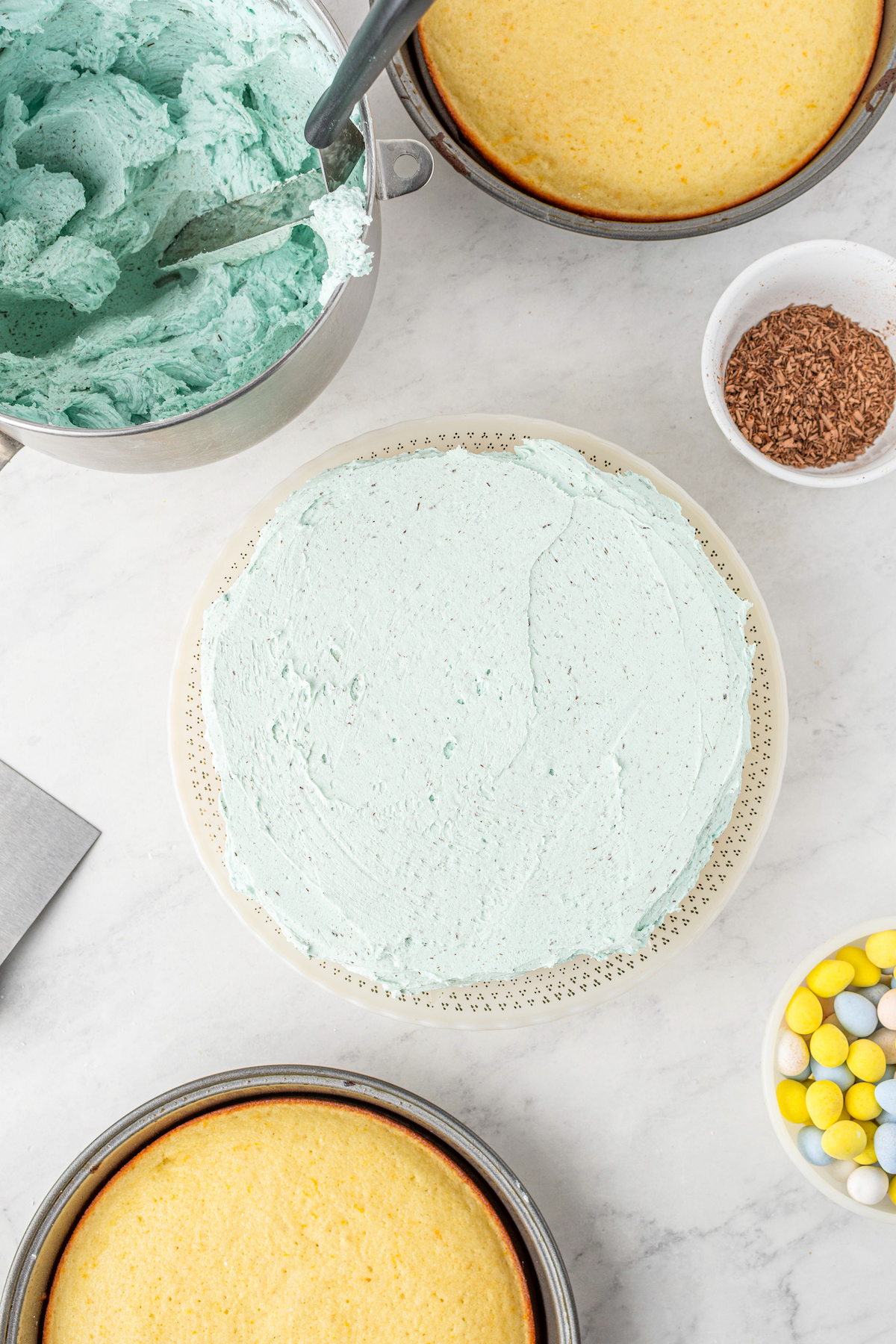
Build the 2nd Layer: Stack the second layer directly on top and gently press down so that it sticks to the layer of buttercream underneath.
Spoon another ½ – ¾ cup of frosting on top and spread again. Spoon a little extra buttercream around the outer ½ inch edge.
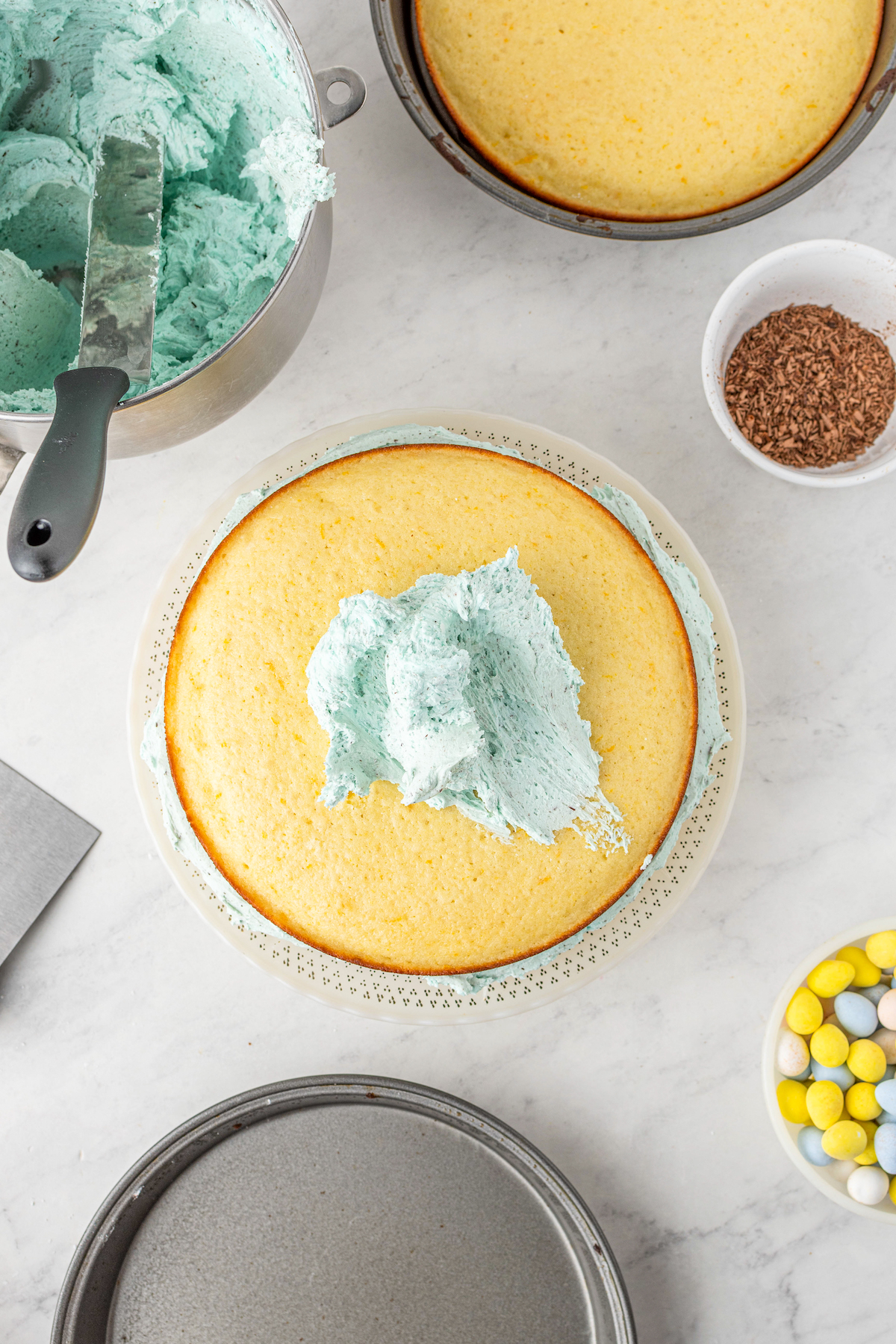
Add the 3rd Layer: Place the last layer on upside down. The extra buttercream lip will make up for the slight dome your last layer of cake will have so that there is no gapping. Placing the top layer on upside down gives us a flat surface to frost making it easier to have even, smooth results.
Smooth Out the Frosting: Frost the top and the sides. Let the frosting on the top and sides be thick so that when we smooth it out, any frosting that gets removed does not leave a bare spot on the cake. Take your offset spatula and place it vertically against the cake at a 45 degree angle and spin your cake stand or plate to start smoothing the frosting.
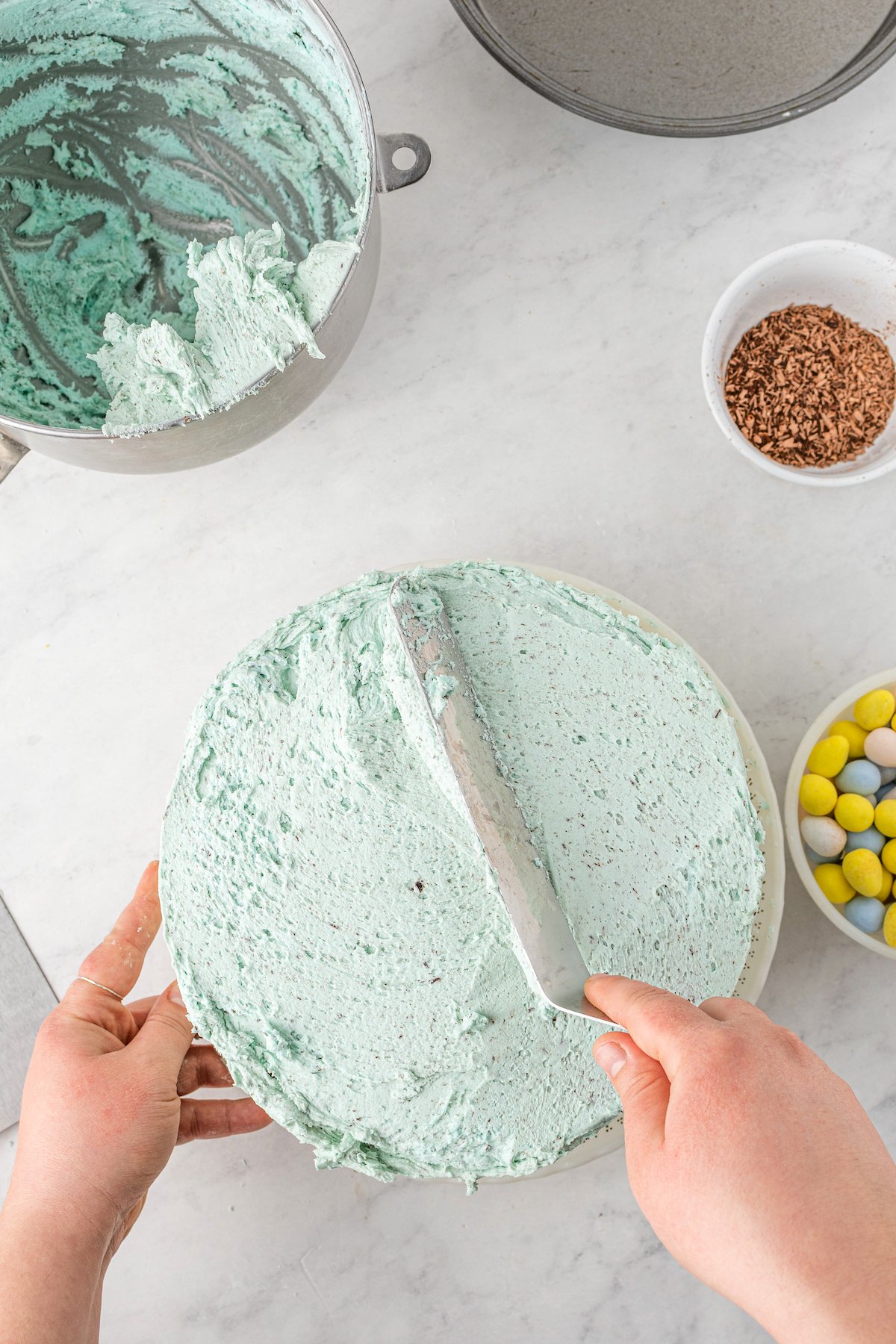
Continue to Smooth Out the Frosting: Once you have a “base” smoothness, scrape any excess frosting off of your spatula and back into the bowl. Using a damp cloth, wipe your offset spatula off and smooth the sides again.
At this point, you should not really be removing much of the frosting, you are just smoothing out any gaps and bumps. Getting a nice smoothness will take a few tries. Between each try, wipe your rag off with the damp rag. The dampness will help smooth the buttercream. Too much moisture on the spatula will cause the buttercream to run or melt so be sure your rag is not soaking wet.
Remove Excess Frosting: Once the sides are smooth, you will notice there is a little “wall” on the top of the cake where the frosting has moved it’s way up and formed a lip on the top edge of the cake. Take your offset spatula and once again, at a 45 degree angle, begin at the edge and pull the frosting in a circular motion towards the center, removing any excess frosting and placing it back into the bowl. After your first smoothing, use the same method as before with the damp rag until the top is smoothed to your liking.
Pipe Frosting Along the Edges of the Cake: You should have about ½ – 1 cup of the buttercream frosting left. Spoon it into a piping bag fitted with a #1A round piping tip. Pipe a dot about the size of a quarter onto the top of the cake near the edge. Using the end of the offset spatula or the back of a spoon, press into the center of the piped dot and pull out and flatten into the buttercream base. Pipe another dot onto the end of the previous “smashed” dot, about ¾ of the way through it and repeat the previous step. Repeat all the way around the edge of the cake to create a wreath effect.
Add the Chocolate Eggs: Using your offset spatula or spoon, dip into the buttercream about 2 cm away from the buttercream wreath and create a little trench, pulling the buttercream towards the center. This will help the mini chocolate eggs stay in place so that they don’t roll into the wreath. Heap eggs into the center of the cake. I got almost an entire package into the center.
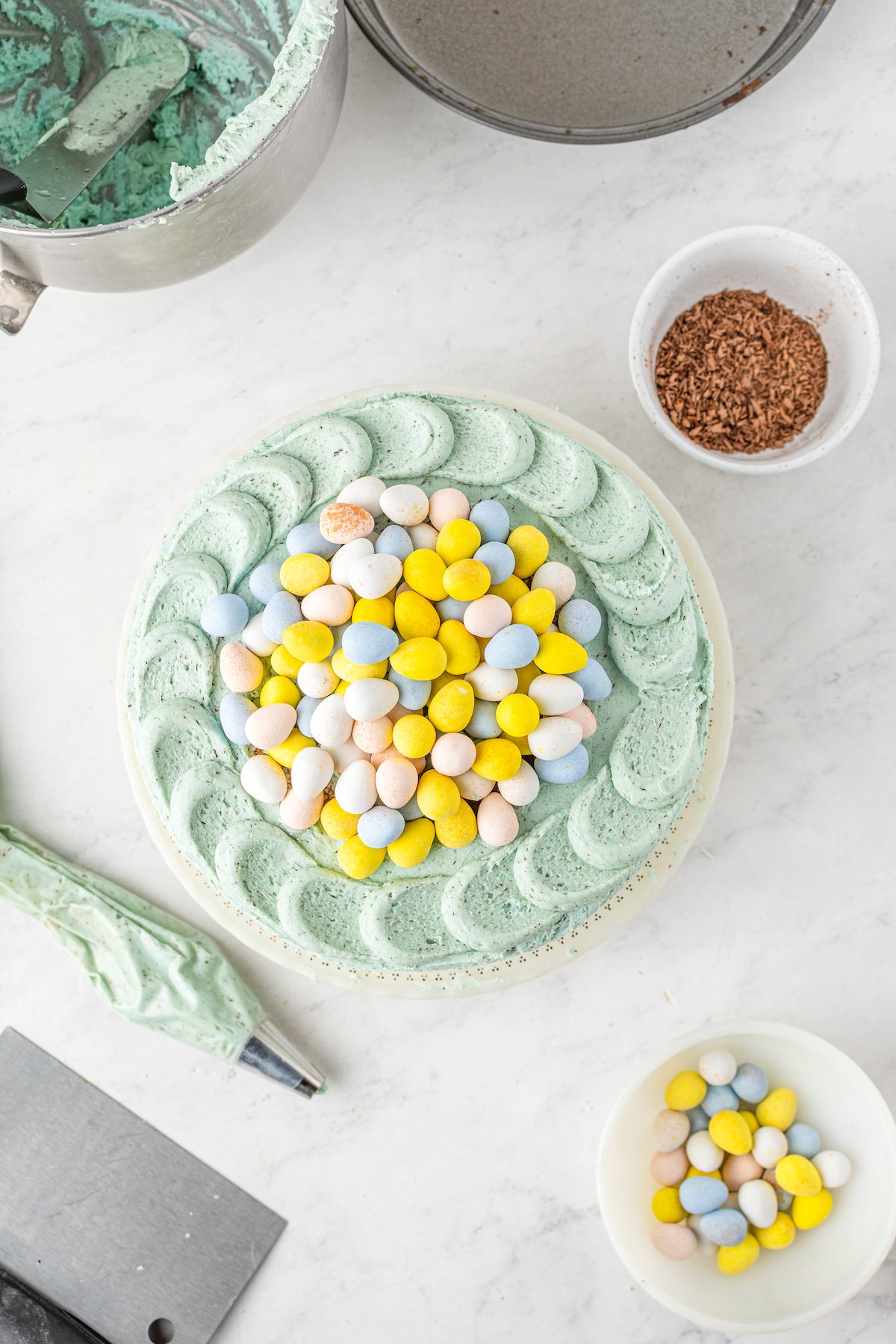
Decorate the Base of the Easter Cake with Shredded Chocolate: With the remaining ¼ c of shredded chocolate, coat the bottom edge of the sides of the cake. Working with a little bit at a time so as not to melt the chocolate, pour a little bit into your hand and press onto the side of the cake. Work your way around until all sides are coated. Brush away any excess chocolate, slice and serve!
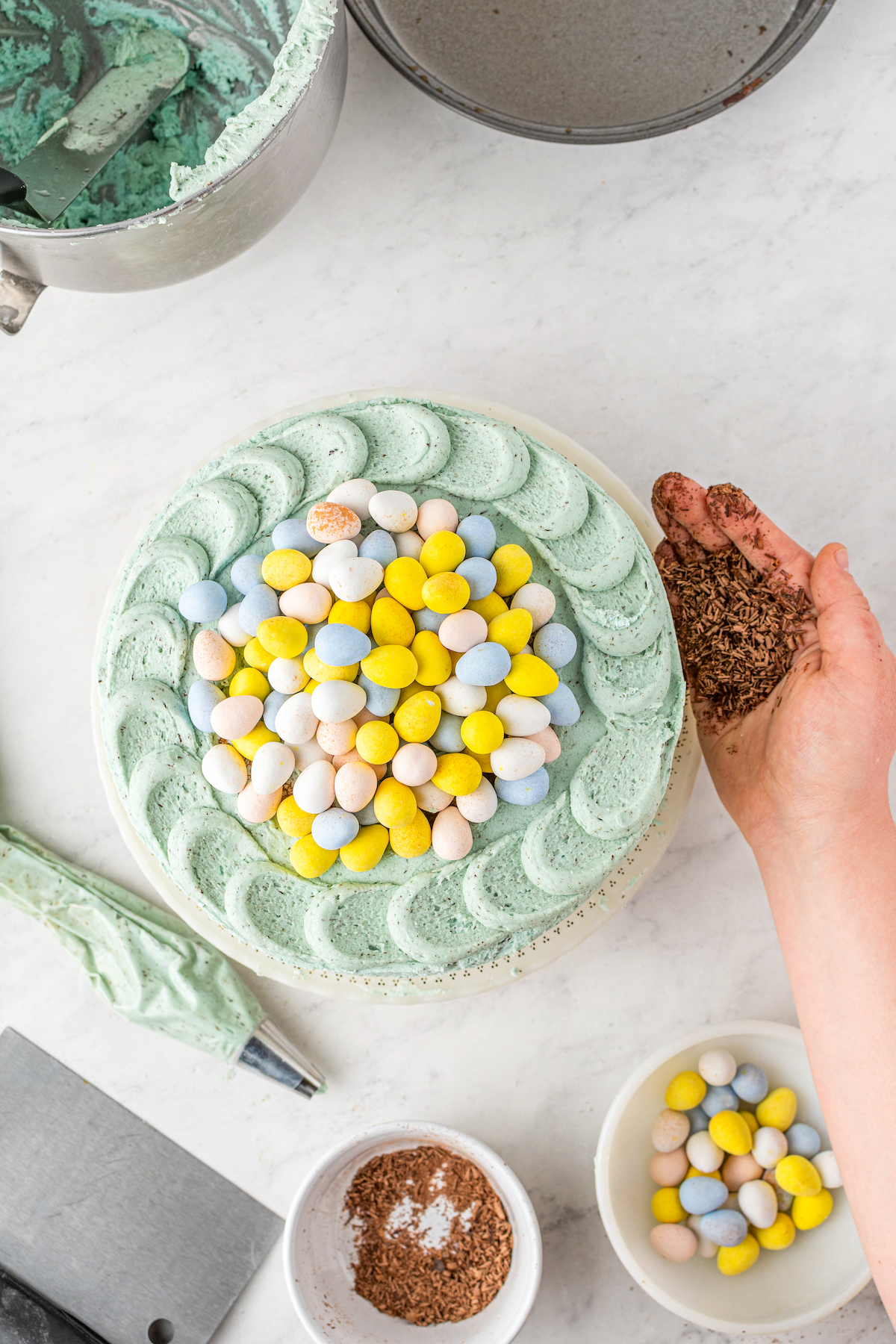
Tips for Easter Cake Success
That was a lot of instruction, I know – still with me?
Awesome, because here are a couple of extra tips to help you perfect your cake:
- If Making the Cake Ahead: Sometimes it’s nice to bake in batches! You can bake the cake layers and then freeze them until you’re ready to make frosting, if need be.
- Don’t Add Too Much Flour: This makes the cake too dense. I recommend spooning the flour into your measuring cup after fluffing it and scraping off the top with a knife.
- Make a Nest for Your Chocolate Eggs: I have also seen people use toasted coconut for a nest and it works great for this! I haven’t tried it, but it would look really cute too.
- Buttercream Substitute: If you’re not a fan of buttercream frosting, try my favorite cream cheese frosting recipe.
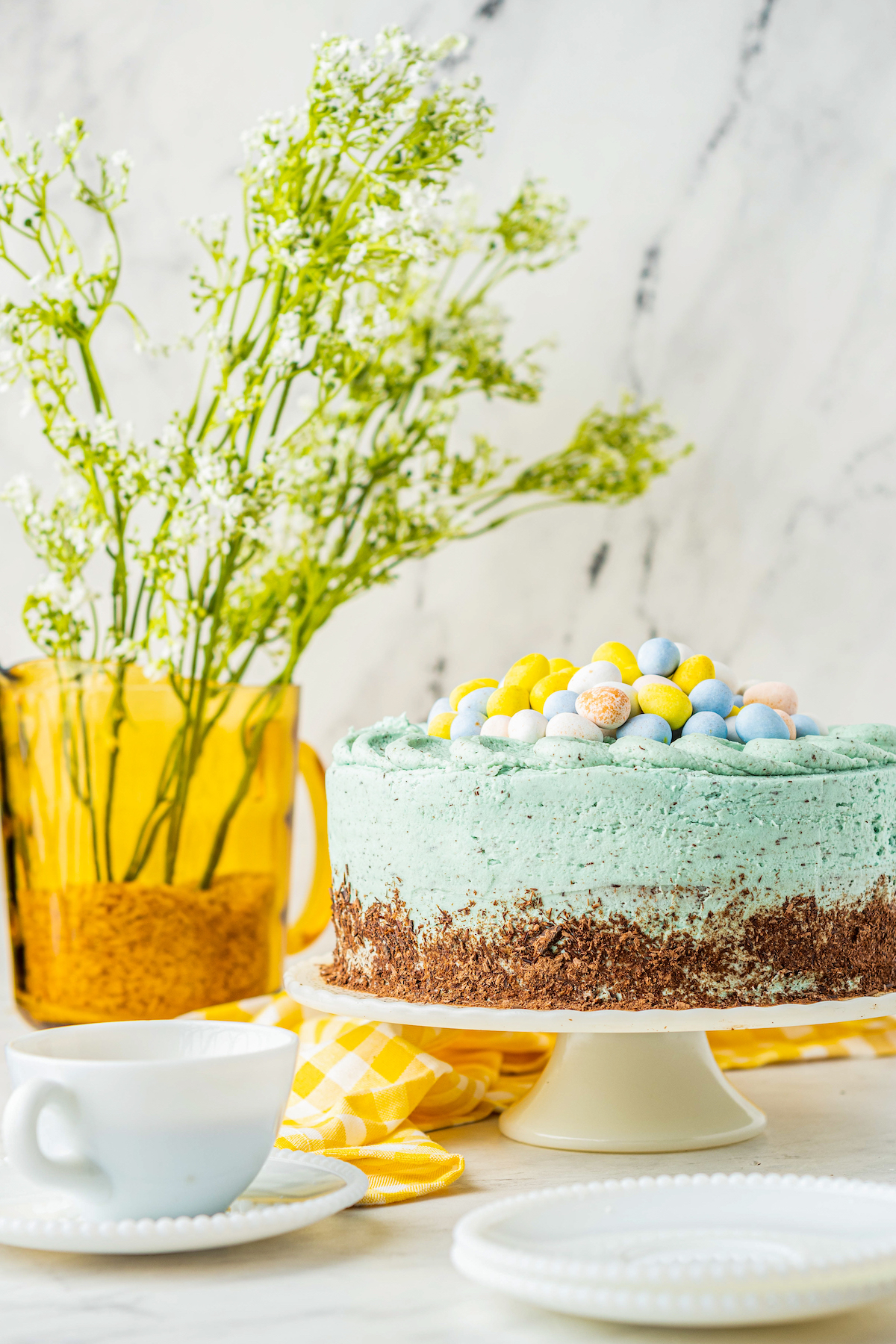
How to Store a Frosted Cake
Store this Easter cake in an airtight container on the counter for up to 2 days. You can also keep it in the fridge for up to 5 days.
If stored in the refrigerator, I recommend letting the cake sit at room temperature for 30 minutes to an hour to warm up a little before serving.
Looking for more gorgeous layer cakes? I have a few popular ones I think you might love:
- My Best Chocolate Cake Recipe
- Best Pumpkin Layer Cake – this is a reader’s favorite every year.
- Chocolate Peanut Butter Cake – my husband’s favorite!
- Best Banana Cake – this is my favorite cake. I make it every year for my birthday!
Easy Easter Cake
Ingredients
For the Cake:
- 2 ⅓ cup all purpose flour
- 1 tablespoon baking powder
- ¾ teaspoon salt
- 1 ½ cup sugar
- 4 large eggs
- 1 cup (2 sticks) unsalted butter, softened
- ¾ cup buttermilk
- ¼ cup greek yogurt, sour cream
- 1 ½ teaspoon orange extract
- Zest from 1 orange
For the Buttercream:
- 1 ½ cups (3 sticks) butter, softened
- 6 cups powdered sugar
- ¼ cup whole milk
- 1 ½ teaspoon vanilla extract
- Pinch of salt
- Blue food coloring
- 1 cup grated/shredded chocolate, separated
For the Topping:
- Cadbury mini chocolate eggs
- Shredded chocolate
Want to save this recipe?
Instructions
For the Cake:
- Preheat the oven to 350°F. Spray three 8-inch cake pans with baking spray and set aside. (You can also use two 9-inch cake pans instead.)
- In a large mixing bowl, whisk together the sugar and eggs until smooth. Add in the butter and whisk for a minute or two until the butter is well integrated.
- Add in the buttermilk, greek yogurt and orange extract. Whisk until smooth. Add in the orange zest and whisk until incorporated.
- In a medium mixing bowl, whisk together the flour, baking powder and salt. Add the flour mixture into the wet mixture and fold together until there are no flour clumps.
- Evenly divide into greased cake pans and place into the preheated oven to bake. For 3 cake pans, bake for 12 to 14 minutes or until a toothpick inserted comes out clean or with moist crumbs and the edges are browned and pulling away from the sides of the pan. (For 2 cake pans, expect the baking time to be about 16 to 18 minutes.)
- Once baked, remove from the oven and place on a cooling rack to cool. While the cakes are cooling, make the buttercream.
- Once the cakes are cooled and the buttercream is made, remove the cakes from the pans.
For the Buttercream:
- In the bowl of a stand mixer, combine butter, powdered sugar, milk, vanilla and salt. Using a paddle or whisk attachment, begin beating on low so that the powdered sugar does not explode everywhere. After a minute or two, once the frosting has started to come together, increase the speed to medium high. Let whip for about 4 minutes or until the buttercream is a light and fluffy texture.
- Add in blue food coloring, a little at a time until you have reached the desired color. Add in ¾ c of the shredded chocolate. Whip for an additional 30 seconds or until the chocolate is well incorporated.
Assemble and Decorate:
- Place one layer onto a cake stand or a plate. Spoon about ½ – ¾ cup of frosting onto the bottom layer. Using an offset spatula or a bench knife, spread the frosting around in an even layer. To ensure there are no gaps or space around the edges where the cakes will be stacked, spread the frosting all the way to the edge without scraping the excess away – we will clean it up later.
- Stack the second layer directly on top and gently press down so that it sticks to the layer of buttercream underneath. Spoon another ½ – ¾ cup of frosting on top and spread again. Spoon a little extra buttercream around the outer ½ inch edge.
- Place the last layer on upside down. The extra buttercream lip will make up for the slight dome your last layer of cake will have so that there is no gapping. Placing the top layer on upside down gives us a flat surface to frost making it easier to have even, smooth results.
- Frost the top and the sides. Let the frosting on the top and sides be thick so that when we smooth it out, any frosting that gets removed does not leave a bare spot on the cake. Take your offset spatula and place it vertically against the cake at a 45 degree angle and spin your cake stand or plate to start smoothing the frosting.
- Once you have a “base” smoothness, scrape any excess frosting off of your spatula and back into the bowl. Using a damp cloth, wipe your offset spatula off and smooth the sides again. At this point, you should not really be removing much of the frosting, you are just smoothing out any gaps and bumps. Getting a nice smoothness will take a few tries. Between each try, wipe your rag off with the damp rag. The dampness will help smooth the buttercream. Too much moisture on the spatula will cause the buttercream to run or melt so be sure your rag is not soaking wet.
- Once the sides are smooth, you will notice there is a little “wall” on the top of the cake where the frosting has moved it’s way up and formed a lip on the top edge of the cake. Take your offset spatula and once again, at a 45 degree angle, begin at the edge and pull the frosting in a circular motion towards the center, removing any excess frosting and placing it back into the bowl. After your first smoothing, use the same method as before with the damp rag until the top is smoothed to your liking.
- You should have about ½ – 1 cup of the buttercream frosting left. Spoon it into a piping bag fitted with a #1A round piping tip. Pipe a dot about the size of a quarter onto the top of the cake near the edge. Using the end of the offset spatula or the back of a spoon, press into the center of the piped dot and pull out and flatten into the buttercream base. Pipe another dot onto the end of the previous “smashed” dot, about ¾ of the way through it and repeat the previous step. Repeat all the way around the edge of the cake to create a wreath effect.
- Using your offset spatula or spoon, dip into the buttercream about 2 cm away from the buttercream wreath and create a little trench, pulling the buttercream towards the center. This will help the mini chocolate eggs stay in place so that they don’t roll into the wreath. Heap eggs into the center of the cake. I got almost an entire package into the center.
- With the remaining ¼ c of shredded chocolate, coat the bottom edge of the sides of the cake. Working with a little bit at a time so as not to melt the chocolate, pour a little bit into your hand and press onto the side of the cake. Work your way around until all sides are coated. Brush away any excess chocolate, slice and serve!
Notes
Nutrition
More Easy Easter Recipes:
- Cool Whip Easter Eggs
- Easter Rice Krispie Cake
- Triple Coconut Cupcakes with Easter Nests on top!
- Best Deviled Eggs
- Ambrosia Salad – my mom’s favorite.
- Easy Crockpot Ham Recipe
- Carrot Cake Cupcakes
- My mom’s Banana Pudding – a reader favorite recipe!
Post may contain affiliate links. Read my disclosure policy.

